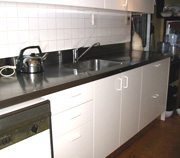Steel – a Metal Finish used in Interior Design
Types of Metal – Steel
There are many types of steel, especially in the industrial area with uses having varying strengths and anti corrosive properties.
They vary by the amount of carbon content in them and their additives or mixtures. You will note that all the metals so far have been ferrous, having been basically made from iron ore.
So is steel, however its main difference is that all the impurities have been oxidised out of the iron and carbon and other minor additives have been mixed with the metal.
We as interior designers are primarily interested in the basic forms of steel such as mild steel and stainless steel. We need to know about steels because they form a very large component of the metal used in buildings today.
We use steel for structural work, such as beams, purlins and girders. As sheet steel for cladding, such as in furniture or stainless steel bench tops and backsplashes also for component work such as brackets, screws and hardware.
The majority of steel that we see in structures is mild steel and sometimes medium carbon steel. These types of steel are also used for light engineering work such as brackets, table legs, pedestals, furniture frames and wall framing. Mild steel when exposed to moisture and air rusts easily, so to prevent that it has to be treated with a protective coating.
There are various systems to coat metals such as electroplating (coating it with another nonferrous metal so that it bonds to the steel), powder coating (a form of spraying on an electrostatically charged powder that sticks to the metal while it is baked on like an enamel), and a number of rust inhibiting paint and or plastic systems. All these systems do a number of things. They change the appearance of the metal by color and texture, they protect the metal from light abrasion and most importantly they stop air and moisture from reaching the steel causing oxidation, which is the rust we see.
The powder coating and paint systems have a particular advantage in that the spectrum of colors available is large which makes them very useful for the designer.
Sheet steel is also usually constructed from mild steel and is usually not more than 3mm thick. The thicker steels we see that appear as sheets, I refer to as plate. Sheet steels are often used for cladding of buildings, or side / top panels to some furniture.
Sheet steels in some situations may be perforated to create a patterned effect such as a lattice or they may be textured to form a pattern. An example of this may be tread plate, the steel plate that we see on stairs on industrial sites. These steels and finishes are very important to the interior designer as they can be used to effect in unusual situations. For example a fashion store aiming at the younger market may use tread plate as shelving for the clothing.

Remember it is up to the designer to establish how different materials may be used. With metals in interiors, unless you’re looking for a particular rustic effect, all ferrous metals should be treated with a coating that inhibits the effect of oxidation.
Another form of steel that doesn’t require a rust inhibitor or oxidation protection is stainless steel. This is a fantastically versatile material for the designer to use should a polished look metal be required in the interior.
We use it on bench tops, in bathrooms, for sanitary fittings for hardware and fixings and it is also used extensively in appliances. Stainless steel is made basically, by adding chrome to the steel mix. It comes in various grades and can also come in a number of colors. The color of stainless steel is made by having a minimum of 13% iron in them and then by immersions in hot solutions of chromic and sulphuric acids. At this stage we don’t really need to get involved in the process but it is necessary to know that there are various colors available.
More Articles on Metals
next page is Non Ferrous Metals
